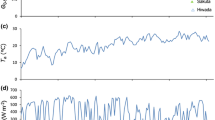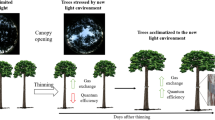Abstract
Previous studies have revealed that the sapwood area at stand scale (A) is an important factor determining changes in transpiration by canopy trees (E). This study examined changes in A for four to six years after thinning of two Japanese cedar and two cypress plantation sites, each having three or four plots with different thinning intensities and one control plot. We focused on whether there was a difference in A (δA) between a thinned plot and a control plot during the experimental period. We observed increased radial stem growth for plots with low stem density (N) due to intensive thinning. However, δA did not decrease to zero during the experimental period for any plot. The increased radial stem growth was not large enough to cancel the effect of low N due to thinning. These results imply that a lower E for thinned plantations as compared to non-thinned plantationsis remains for several years (more than 10 years, according to our results) after thinning and that thinning could be an effective method of reducing water consumption by canopy trees.







Similar content being viewed by others
References
Alsheimer M, Köstner B, Falge E, Tenhunen JD (1998) Temporal and spatial variation in transpiration of Norway spruce stands within a forested catchment of the Fichtelgebirge, Germany. Ann Sci For 55:103–123. doi:10.1051/forest:19980107
Bréda N, Granier A, Aussenac G (1995) Effects of thinning on soil and tree water relations, transpiration and growth in an oak forest (Quercus petraea (Matt.) Liebl.). Tree Physiol 15:295–306. doi:10.1093/treephys/15.5.295
Dung BX, Miyata S, Gomi T (2011) Effect of forest thinning on overland flow generation on hillslopes covered by Japanese cypress. Ecohydrology 4:367–378. doi:10.1002/eco.135
Ford CR, Laseter SH, Swank WT, Vose JM (2011) Can forest management be used to sustain water-based ecosystem services in the face of climate change? Ecol Appl 21:2049–2067. doi:10.1890/10-2246.1
Forestry and Forest Products Research Institute (2010) Points for intensive thinning operation of dense stands. Forestry and Forest Products Research Institute, Kochi. (Available at http://www.ffpri-skk.affrc.go.jp/seika/kyodokanbatusegyo.pdf)
Fujimori T (2000) Living with forests. Maruzen, Tokyo
Fukada H, Watanabe N, Miyata H, Yamasaki T (2009) Effect on growth and quality of remained trees by strong thinning. Bull Kochi Pref For Tech Cen 34:56–83
Hayashi S, Sakai K (1972) Competition in relation to growth of trees in Cryptomeria forests. J Jpn For Soc 54:218–225
Imawaka S, Sato N (2008) Study on new forest maintenance projects by “Forest Environmental Tax”. Bull Kyushu Univ For 89:75–126
Japan Forestry Agency (2013) White paper for forest and forestry. Japan Forestry Agency, Tokyo. (Available at: http://www.rinya.maff.go.jp/j/kikaku/hakusyo/index.html)
Kawahara T, Kamo K, Isagi Y, Kiyono Y (1989) Experiment of exploitation thinning in young Cryptomerria japonica and Chamaecyparis obtusa stands. Bull FFPRI 356:47–62
Kiyono Y (1988) Analyses of factors affecting the dynamics of coverage and number of species in understories in Chamaecyparis obtusa plantations. J Jpn For Soc 70:455–460
Komatsu H (2010) Forests and water resources. Suiri Kagaku 314:1–29
Komatsu H, Kume T, Otsuki K (2008) The effect of converting a native broad-leaved forest to a coniferous plantation forest on annual water yield: a paired-catchment study in northern Japan. For Ecol Manage 255:880–886. doi:10.1016/j.foreco.2007.10.010
Komatsu H, Kume T, Otsuki K (2009) Effects of coniferous plantation thinning on annual interception evaporation: model verification. J Jpn For Soc 91:94–103
Komatsu H, Kume T, Otsuki K (2010) Water resource management in Japan-forest management or dam reservoirs? J Environ Manage 91:814–823. doi:10.1016/j.jenvman.2009.10.011
Komatsu H, Shinohara Y, Nogata M, Tsuruta K, Otsuki K (2013) Changes in canopy transpiration due to thinning of a Cryptomeria japonica plantation. Hydrol Res Lett 7:60–65. doi:10.3178/hrl.7.60
Kumagai T, Nagasawa H, Mabuchi T, Ohsaki S, Kubota K, Kogi K, Utsumi Y, Koga S, Otsuki K (2005) Sources of error in estimating stand transpiration using allometric relationships between stem diameter and sapwood area for Cryptomeria japonica and Chamaecyparis obtusa. For Ecol Manage 206:191–195. doi:10.1016/j.foreco.2004.10.066
Kume T, Tsuruta K, Komatsu H, Kumagai T, Higashi N, Shinohara Y, Otsuki K (2010) Effects of sample size on sap flux-based stand-scale transpiration estimates. Tree Physiol 30:129–138. doi:10.1093/treephys/tpp074
Kunisaki T (2001) DBH distribution dynamics of even-aged tree populations: in the case of conifers. Jpn J For Plan 35:31–45
Kuraji K (2003) Effects of forests on stabilizing streamflow. Nihon Chisan-Chisui Kyokai, Tokyo
Lagergren F, Lankreijer H, Kučera J, Cienciala E, Mölder M, Lindroth A (2008) Thinning effects on pine-spruce forest transpiration in central Sweden. For Ecol Manage 255:2312–2323. doi:10.1016/j.foreco.2007.12.047
Licata JA, Pypker TG, Weigandt M, Unsworth MH, Gyenge JE, Fernández ME, Schlichter TM, Bond BJ (2011) Decreased rainfall interception balances increased transpiration in exotic ponderosa pine plantations compared with native cypress stands in Patagonia, Argentina. Ecohydrology 4:83–93. doi:10.1002/eco.125
Macfarlane C, Bond C, White D, Grigg AH, Ogden GN, Silberstein R (2010) Transpiration and hydraulic traits of old and regrowth eucalypt forest in southwestern Australia. For Ecol Manage 260:96–105. doi:10.1016/j.foreco.2010.04.005
Miyamoto K, Okuda S, Inagaki Y, Kodani E, Noguchi M, Itou T (2009) Comparison of growth performance and leaf area index in Hinoki cypress (Chamaecyparis obtusa) plantations 5 years after thinning. Jpn J For Environ 51:21–26
Moore G, Bond BJ, Jones JA, Meinzer FC (2010) Thermal-dissipation sap flow sensors may not yield consistent sap-flux estimates over multiple years. Trees 24:65–174. doi:10.1007/s00468-009-0390-4
Morikawa Y, Hattori S, Kiyono Y (1986) Transpiration of a 31-year-old Chamaecyparis obtusa Endl. stand before and after thinning. Tree Physiol 2:105–114. doi:10.1093/treephys/2.1-2-3.105
Morotomi T, Numao N (2012) Fiscal science of water and forest. Nippon-Keizai-Hyoronsha, Tokyo
Murakami S, Tsuboyama Y, Shimizu T, Fujieda M, Noguchi S (2000) Variation of evapotranspiration with stand age and climate in a small Japanese forested catchment. J Hydrol 227:114–127. doi:10.1016/S0022-1694(99)00175-4
Onda Y, Gomi T, Mizugaki S, Nonoda T, Sidle RC (2010) An overview of the field and modeling studies on the effect of forest devastation on flooding and environmental issues. Hydrol Process 24:527–534. doi:10.1002/hyp.7548
Sawano S, Komatsu H, Suzuki M (2005) Differences in annual precipitation amounts between forested area, agricultural area, and urban area in Japan. J Jpn Soc Hydrol Water Resour 18:435–440
Takeuchi I, Tadaki Y, Hchiya K, Kawahara T, Sato A (1975) Thinning experiment of 30-year-old plantation of Chamaecyparis obtusa—In reference to line-thinning—. Bull Gov For Exp Sta 272:141–155
Tamai S, Ohkubo Y, Tsutsumi T (1983) Studies on the effects of thinning small-diameter trees (VI) changes in structure and biomass of a Cryptomeria japonica stand during twelve years after thinning. J Jpn For Soc 65:372–381
Trisurat Y, Alkemade R, Verburg PH (2010) Projecting land-use change and its consequences for biodiversity in northern Thailand. Environ Manage 45:626–639. doi:10.1007/s00267-010-9438-x
Tsukamoto Y (1998) Conservation of forest, water, and soil. Asakura, Tokyo
Tsuruta K, Komatsu H, Shinohara Y, Kume T, Ichihashi R, Otsuki K (2011) Allometric equations between stem diameter and sapwood area of Japanese cedar and Japanese cypress for stand transpiration estimates using sap flow measurement. J Jpn Soc Hydrol Water Resour 24:261–270
Vertessy RA, Watson FGR, O’Sullivan SK (2001) Factors determining relations between stand age and catchment water balance in mountain ash forests. For Ecol Manage 143:13–26. doi:10.1016/S0378-1127(00)00501-6
Yashiro Y, Lee NYM, Ohtsuka T, Shizu Y, Saitoh TM, Koizumi H (2010) Biometric-based estimation of net ecosystem production in a mature Japanese cedar (Cryptomeria japonica) plantation beneath a flux tower. J Plant Res 123:463–472. doi:10.1007/s10265-010-0323-8
Acknowledgments
We acknowledge Dr. Kenji Tsuruta (Kyoto University, Japan) for providing data of the sapwood area at tree scale. Thanks are also due to two anonymous reviewers for their useful comments. This research was supported by a CREST project (Development of Innovative Technologies for Increasing in Watershed Runoff and Improving River Environment by the Management Practice of Devastated Forest Plantation).
Author information
Authors and Affiliations
Corresponding author
Electronic supplementary material
Below is the link to the electronic supplementary material.
About this article
Cite this article
Komatsu, H., Kume, T. Changes in the sapwood area of Japanese cedar and cypress plantations after thinning. J For Res 20, 43–51 (2015). https://doi.org/10.1007/s10310-014-0468-8
Received:
Accepted:
Published:
Issue Date:
DOI: https://doi.org/10.1007/s10310-014-0468-8




